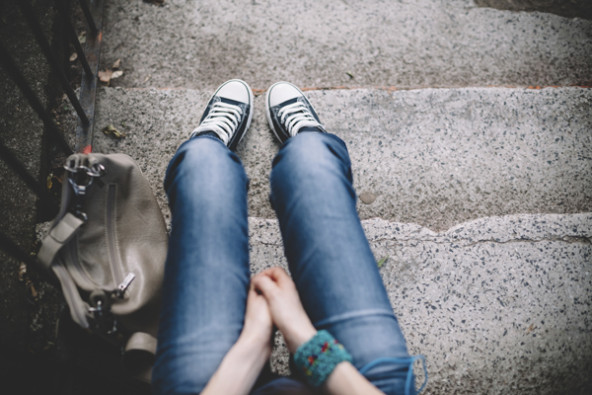Arlene Baldwin left high school when she was 17. “I was just sick and tired of people around me dying,” she said. “I couldn’t take it. I couldn’t focus. I couldn’t go to school because I felt like no one there understood.”
Now 21, Baldwin is a senior in college. What made the difference? “I had other people who just didn’t give up,” she told us, giving the lion’s share of the credit to the staff at the Center for Teen Empowerment in Boston.
“Having adults in my life who weren’t family and who still believed in me, it was amazing. And it wasn’t just one.” Despite extreme challenges in her teen years, Baldwin found a network of supportive adults and peers to help her re-engage in school.
But not all young people are so lucky. Our research team at the Center for Promise recently surveyed 2,800 18-to-25 year olds across the country, and conducted in-depth individual and group interviews with more than 120 young people in eight cities. As the study illuminates, too many young people today suffer from a kind of “relationship poverty”—not a lack of love or family, but a lack of access to additional sources of support that can help lead them to a more promising future.
Are you enjoying this article? Read more like this, plus SSIR's full archive of content, when you subscribe.
Here are a few central findings:
Too many young people face too many hurdles with too little help. About half of all young people who leave school have hit an “adversity cliff,” meaning they’ve experienced not just one or two, but five or more “adverse life experiences,” such as homelessness, mental illness, becoming a parent, or expulsion. Young people facing the greatest adversity need more intensive support than family, school, and friends can typically provide. Even with a high level of support from multiple sources, fewer than half of young people who have hit an adversity cliff in their teens will graduate without intensive help handling the trauma and challenges in their lives.
The type and source of support matters. Young people who receive both emotional support (love) and instrumental support (tangible resources like bus passes or babysitting) from parents or adults at school are 20 percent less likely to leave school than those without these supports.
The more sources of support, the better. For young people with two to four adverse life experiences, a high level of support from both parents and adults outside school increases the odds of them staying in school 11 percent more than support from parents alone. Adding a third source of support—friends—boosts likely continuous enrollment by another 5 percent.
Young people need an anchor relationship and a web of support. Young people who have experienced many disappointing relationships in their lives told us they need a stable, consistent presence to be able to see, trust, and accept help from a network of caring, supportive adults. As the report states, “Some young people may be standing in a room that contains all the support they need, but they need someone else to turn on the lights so they can see what’s there and reach for it.”
 When asked why they returned to high school after not graduating on time, young people most frequently responded that someone encouraged them to return. (Photo by iStock)
When asked why they returned to high school after not graduating on time, young people most frequently responded that someone encouraged them to return. (Photo by iStock)
So how can community organizations, schools, and nonprofits turn on that light?
1. Start by assessing risks and resources. Organizations can’t fix problems they don’t understand. Conducting needs assessments, undertaking community asset mapping, and developing a clear picture of both the risks and the resources in young people’s lives is an essential foundation for strategic intervention in graduation rates.
A few starting points: For asset mapping, take a look at Search Institute’s Developmental Assets Profile. For health-related risks, see whether your state participates in the Youth Risk Behavior Survey. For examples of state-level surveys, check out the Iowa Youth Survey, the California Healthy Kids Survey, or the Oregon Healthy Teen Survey.
2. Make it harder to leave and easier to return. Monitoring attendance patterns and making it easier to transfer credits for students who change schools are important ways schools can prevent students from leaving. But cities can also make it easier to return through reconnection and re-engagement centers. Boston and Portland offer great examples of cities that help young people consider their options for returning.
3. End zero-tolerance disciplinary policies. Once students are suspended or expelled, their risk of leaving school altogether more than doubles. Moreover, research shows that these policies unfairly target students of color.
Switching from out-of-school to in-school suspension and giving young people the chance to make up the work they have missed is a much more effective way to help them stay on track. Check out relationship-focused interventions like Collaborative & Proactive Solutions (CPS) or restorative justice practices.
4. Invest in building relationships. The National Mentoring Resource Center offers free mentoring materials and technical assistance. Use professional development resources like My Teaching Partner, which coaches middle and high school teachers to enhance the quality of their interactions with students. And take a look at efforts dedicated to socio-emotional learning such as the Collaborating Districts Initiative and Transforming Education’s Mindsets, Essential Skills, and Habits.
By understanding how relationship poverty prevents students from getting their diplomas, we can begin to change the conversation about what they need to graduate. By increasing the quality and quantity of supportive relationships in their lives, we can help more young people find what Baldwin found—a network of people dedicated to helping her get an education and, with it, a better life.
Support SSIR’s coverage of cross-sector solutions to global challenges.
Help us further the reach of innovative ideas. Donate today.
Read more stories by John Gomperts.

